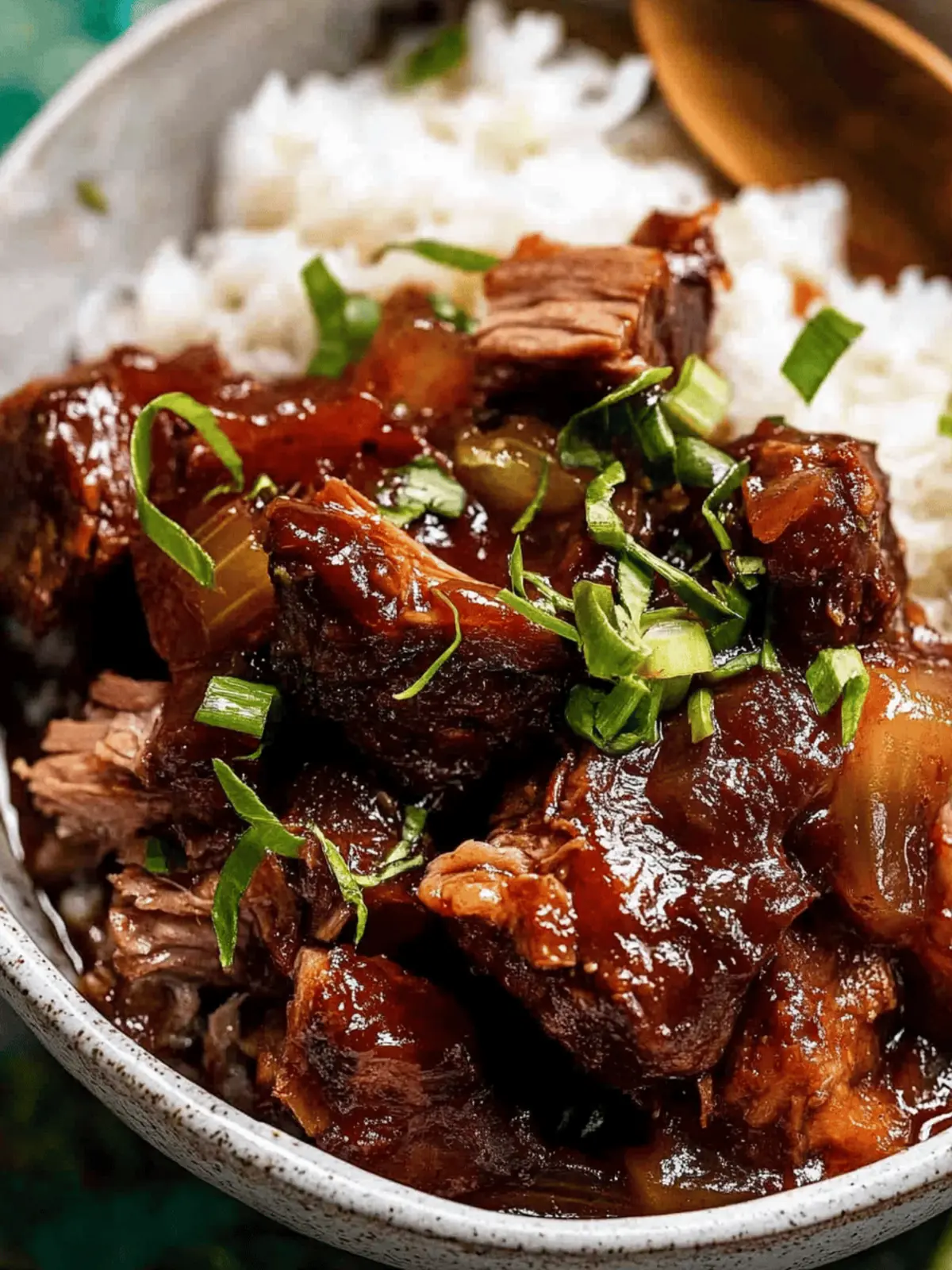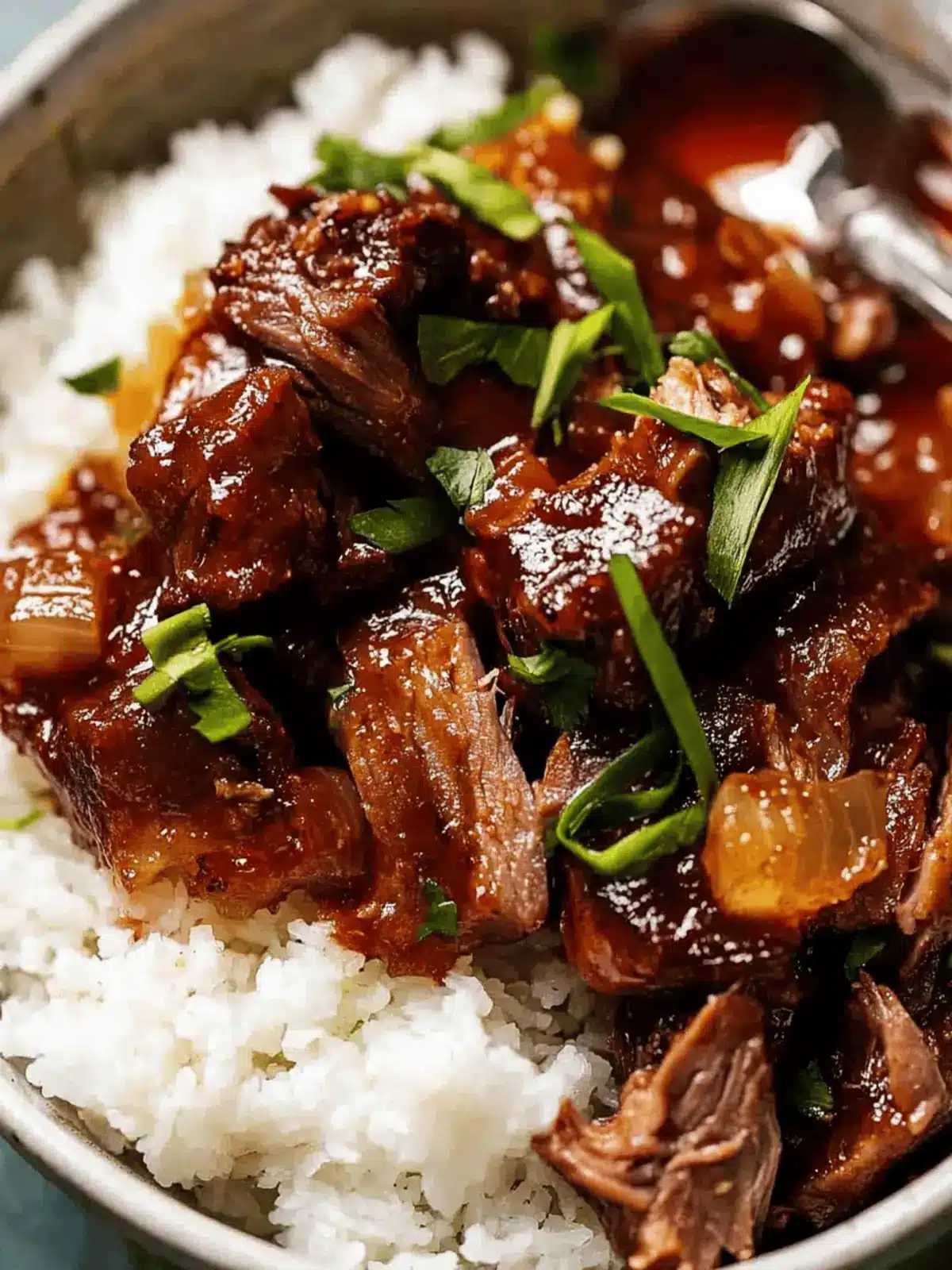There’s a certain magic that happens in the kitchen when the rich aroma of soy sauce and garlic fills the air. It’s just like a warm embrace from a long-lost friend, and that’s exactly what Slow-Cooked Filipino Pork Adobo brings to the table. This dish is more than just a recipe; it’s a cherished tradition, steeped in history and love. The tender pork melds beautifully with a savory-sweet sauce, and if you’re feeling adventurous, a hint of pineapple adds an unexpected twist that dances on your palate.
I first discovered this delightful recipe during a family gathering, where it quickly became the star of the show, drawing everyone in for seconds (and thirds!). The best part? It’s a one-pot meal that’s incredibly easy to whip up, making it perfect for busy weeknights or intimate dinners. With every bite, you’ll savor the harmony of flavors that showcase the best of Filipino cuisine. So roll up your sleeves, and let’s dive into this comforting classic that will warm your heart and home like no fast food ever could!
Why Is Filipino Pork Adobo So Loved?
Easy to Prepare: This recipe shines with its simple steps, ensuring that even beginner cooks can enjoy a hassle-free experience in the kitchen.
Flavor Explosion: The blend of soy sauce, garlic, and optional pineapple creates a unique depth that makes each bite utterly irresistible.
One-Pot Wonder: This dish simplifies cleanup, as everything cooks together beautifully in one pot.
Adaptable Ingredients: Whether you’re using pork, chicken, or beef, you can easily tweak the recipe to suit your pantry, making it versatile for any occasion.
Crowd-Pleasing Delight: Perfect for family dinners or gatherings, the comforting flavors of this dish celebrate Filipino heritage, sure to impress and satisfy your guests.
Filipino Pork Adobo Ingredients
• A delightful mix of flavors awaits!
For the Meat
- Pork Shoulder – The ideal choice for its perfect fat-to-meat ratio, ensuring a tender result; can be substituted with pork belly, shank, or neck.
- Pineapple (optional) – Fresh or canned for a hint of sweetness that balances the pork’s richness; use in juice, not syrup.
For the Marinade and Sauce
- Light Soy Sauce – The main seasoning that adds saltiness and umami; can be swapped with all-purpose soy for versatility, but avoid dark soy.
- Dark Soy Sauce – Brings color and depth to the sauce; though optional, it’s recommended for a richer flavor.
- Rice Vinegar – Adds necessary tanginess to brighten the dish; white wine or apple cider vinegar works as a substitute.
For the Aromatics
- Vegetable Oil – Ideal for searing the pork; choose any neutral oil you have on hand!
- Onion – A fragrant base that adds sweetness and depth; cutting into wedges ensures even cooking.
- Garlic – Sliced finely to infuse the entire dish with flavor.
For the Cooking Liquid
- Water – Essential for braising the pork and developing that delicious sauce.
For Seasoning
- Brown Sugar – Adds sweetness and a touch of caramel flavor; can be replaced with regular sugar or honey (just reduce the amount).
- Black Peppercorns – Optional for a hint of spice; ground black pepper can be used if you prefer.
For the Herbal Note
- Bay Leaves – Infuse the dish with earthiness; fresh are best but dried will work too.
For Garnish
- Green Onion – Adds a refreshing crunch and brightens the presentation when sprinkled on top just before serving.
With these ingredients, you’re set to make a stunning Filipino Pork Adobo!
How to Make Filipino Pork Adobo
- Sear Pork: Heat vegetable oil in a heavy pot over medium-high heat. Sear pork shoulder in batches until golden brown, about 4 minutes per batch. Remove and set aside to lock in those delicious juices.
- Sauté Aromatics: In the same pot, lower the heat and add the onion wedges. Sauté for about 2 minutes until softened, then toss in the finely sliced garlic and cook for another minute until fragrant.
- Combine for Braising: Stir in water, light soy sauce, dark soy sauce, rice vinegar, brown sugar, black peppercorns, and bay leaves. Add back the seared pork along with any juices collected.
- Slow Cook: Bring the mixture to a boil, then reduce heat to a gentle simmer. Cover partially and let cook for 1.5 hours, or until the pork is tender and infused with flavors.
- Caramelize Pineapple (if using): In a separate pan, heat a little oil and cook the pineapple pieces until golden and slightly caramelized on both sides. Set aside to enhance their sweetness.
- Reduce Sauce: After removing the pork from the pot, increase the heat and boil the sauce until it reduces to about 1.5 cups, approximately 8-10 minutes. You want it to thicken and become glossy.
- Coat and Serve: Stir the tender pork and caramelized pineapple into the reduced sauce. Serve this delightful concoction over steaming jasmine rice, garnished with fresh green onions for that refreshing crunch.
Optional: Add a sprinkle of sesame seeds for an extra touch of flavor and texture!
Exact quantities are listed in the recipe card below.
Expert Tips for Filipino Pork Adobo
- Choose Quality Meat: Opt for pork shoulder or belly which provides the best balance of fat and tenderness for this Filipino Pork Adobo.
- Gentle Simmering: Keep the cooking temperature low when simmering; a vigorous boil can toughen the meat, so opt for small, gentle bubbles instead.
- Flavor Balance: Adjust the rice vinegar towards the end of cooking to customize the tartness; start with the recommended amount and modify according to taste.
- Caramelizing Pineapple: If using pineapple, ensure to caramelize it until golden for a concentrated sweetness that beautifully complements the rich sauce.
- One-Pot Wonder: Remember, all ingredients should be cooked together in one pot to maximize flavor; avoid using a slow cooker to enhance the sauce’s depth through caramelization.
Make Ahead Options
These savory Filipino Pork Adobo bites are perfect for meal prep enthusiasts! You can marinate the pork shoulder in the sauce (soy sauce, vinegar, and seasonings) up to 24 hours in advance, allowing the flavors to deeply infuse. Additionally, you can chop the onions and garlic a day ahead, storing them in an airtight container in the refrigerator. The final steps are simple: when ready to serve, simply sear the marinated pork, sauté the aromatics, and slow-cook everything until tender. For the best quality, avoid pre-cooking the pork, as it will keep just as delicious when prepared fresh. Enjoy a stress-free cooking experience on busy weeknights with this delightful dish!
Storage Tips for Filipino Pork Adobo
- Fridge: Store your leftover Filipino Pork Adobo in an airtight container for up to 4 days. The flavors will continue to meld, making it even more delightful on the second day.
- Freezer: For longer storage, freeze the adobo in an airtight container or freezer bag for up to 3 months. Be sure to label the container with the date for easy tracking.
- Thawing: Thaw frozen Filipino Pork Adobo in the fridge overnight before reheating. This helps maintain its tender texture.
- Reheating: Gently reheat on the stove over low heat, adding a splash of water if needed to loosen the sauce. Enjoy your flavorful leftovers just like the first time!
What to Serve with Filipino Pork Adobo?
To create a comforting, heartwarming meal, consider these delightful pairings that elevate your dining experience.
- Jasmine Rice: A classic choice, fluffy jasmine rice absorbs the rich, savory sauce, balancing the flavors beautifully. Each scoop fulfilled with juicy pork makes every bite a taste of home.
- Garlic Fried Rice (Sinangag): For a fragrant twist, this savory fried rice enhances the adobo’s richness, making your meal even more indulgent. The hint of garlic brings an inviting aroma to your table.
- Fresh Cucumber Salad: Crisp cucumbers provide a refreshing crunch that cuts through the richness of the pork. A simple vinaigrette can enliven the dish, adding brightness and balance to your plate.
- Steamed Vegetables: A side of steamed broccoli or green beans introduces a nutritious element, maintaining the dish’s comforting essence while adding vibrant color and texture.
- Mango Salad: Sweet, ripe mango slices introduce a lovely contrast, blending tropical sweetness with the savory depth of the adobo. This combination is a refreshing palate cleanser between bites.
- Lemonade: Pair your meal with a chilled glass of homemade lemonade to counterbalance the adobo’s savory flavors with a zesty freshness. The sweetness of the lemonade enhances your overall dining satisfaction.
- Pineapple Upside-Down Cake: For dessert, this classic cake mirrors the pineapple used in the adobo, creating a harmonious flow of flavors that will leave your guests swooning for more. Each slice brings a delightful end to your meal!
Filipino Pork Adobo Variations
Feel free to personalize your dish with these delightful twists that will elevate your Filipino Pork Adobo experience!
- Chicken Swap: Replace pork with chicken thighs or breasts; adjust cooking time to about 40 minutes for juicy results.
Chicken brings a lighter flavor while still soaking up the delicious sauce. - Beef Touch: Use beef chuck for a hearty version; cook longer for tenderness.
The richer taste of beef adds a bold dimension that pairs wonderfully with the savory sauce. - Vegetarian Delight: Swap the meat for extra-firm tofu, sautéed until golden for added texture.
This variation makes it a comforting dish for plant-based eaters without losing the essence of Adobo. - Coconut Cream: Instead of pineapple, incorporate a cup of coconut milk for a creamy twist.
This variation creates a velvety sauce, lending a slightly sweet, tropical flair that’s simply irresistible. - Add Veggies: Toss in bell peppers, carrots, or green beans during the last 20 minutes of cooking for vibrant color and nutrition.
Fresh vegetables not only enhance visual appeal but also add layers of flavor and crunch to every bite. - Smoky Flavor: Incorporate a teaspoon of smoked paprika to introduce a subtle smokiness.
This unexpected addition intriguingly complements the sauce, giving it a unique depth. - Herb Infusion: Experiment with fresh herbs like cilantro or parsley as a garnish for a pop of freshness.
These herbs brighten the dish, creating a lovely contrast with the rich sauce. - Spicy Kick: Add sliced green chilies or a dash of chili flakes for a spicy version.
For those who appreciate heat, this variation adds an exciting, fiery twist to the traditional flavors.
Filipino Pork Adobo Recipe FAQs
What type of pork is best for Filipino Pork Adobo?
Absolutely! Pork shoulder is the ideal choice for Filipino Pork Adobo due to its perfect balance of fat and meat, ensuring a tender and flavorful outcome. You can also use pork belly, shank, or neck if you prefer a different cut.
How should I store Filipino Pork Adobo after cooking?
I recommend storing your leftover Filipino Pork Adobo in an airtight container in the refrigerator for up to 4 days. This allows the flavors to deepen and meld beautifully, making it even more delicious on day two!
Can I freeze Filipino Pork Adobo?
Very! To freeze your adobo, pour it into an airtight container or freezer bag, making sure to leave some space for expansion. It will keep well for up to 3 months. Just remember to label it with the date!
What’s the best way to reheat Filipino Pork Adobo?
To reheat, gently thaw the frozen Filipino Pork Adobo in the refrigerator overnight. Then, warm it up in a pot over low heat, adding a splash of water if the sauce has thickened too much. This method ensures you retain that mouth-watering tenderness.
What if I want to adjust the sweetness or tanginess?
If you wish to adjust the flavors, start by tweaking the rice vinegar; add a little at a time towards the end of cooking to reach your desired level of tanginess. Similarly, you can adjust the amount of brown sugar for sweetness — just be sure to make small increments and taste along the way!
Is there a way to make Filipino Pork Adobo pet-friendly?
Certainly! While the rich flavors in Filipino Pork Adobo are for human taste buds, you can set aside some plain, cooked pork before adding the soy sauce and other ingredients. Just be sure to avoid any salt, garlic, or onion, which can be harmful to pets.

Savory Filipino Pork Adobo with Sweet Pineapple Twist
Ingredients
Equipment
Method
- Heat vegetable oil in a heavy pot over medium-high heat. Sear pork shoulder in batches until golden brown, about 4 minutes per batch. Remove and set aside.
- In the same pot, lower the heat and add the onion wedges. Sauté for about 2 minutes until softened, then add the finely sliced garlic and cook for another minute until fragrant.
- Stir in water, light soy sauce, dark soy sauce, rice vinegar, brown sugar, black peppercorns, and bay leaves. Add back the seared pork along with any juices collected.
- Bring the mixture to a boil, then reduce heat to a gentle simmer. Cover partially and let cook for 1.5 hours, or until the pork is tender.
- In a separate pan, heat a little oil and cook the pineapple pieces until caramelized on both sides. Set aside.
- After removing the pork, increase the heat and boil the sauce until it reduces to about 1.5 cups, approximately 8-10 minutes.
- Stir the tender pork and caramelized pineapple into the reduced sauce. Serve over jasmine rice, garnished with fresh green onions.











